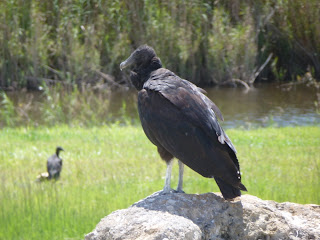As we were checking out of the hotel, we were told by the receptionist that all the trees in the hotel grounds were labelled with their botanical names. So, here we have another photo of the palm with silver-green leaves, which is a Silver Bismark Palm from Madagascar.
We left the hotel at about 9.30am and drove across Captiva and then Sanibel Islands. Descending from the bridge that links Sanibel to the mainland.
We left the busy coastal strip for the 150 mile drive across central Florida to Fort Pierce on the eastern coast. It was a lovely drive through citrus growing areas and, on several occasions, we came up behind trucks laden with oranges.
Halfway across the peninsula, we reached Lake Okeechobee, a huge freshwater lake that covers an area of 750 square miles, yet has a maximum depth of only 14 feet. We took a side road down to a viewing point where we could see across the large area of marshy ground to the lake in the distance. It is a haven for wildlife, especially birds. We saw this vulture as we drove into the lake area. It was sitting on a rock watching another vulture pecking at a dead tortoise.
As we were looking at the birds, three airboats hurtled along a waterway towards us.
An egret feeding in the shallows.
Lake Okeechobee in the distance.
We must have seen dozens of storks (or are they herons?) on our travels through Florida.
We left the viewpoint and drove a further ten miles around the levee that protects the surrounding countryside from flooding by Lake Okeechobee in the rainy season. We stopped again and there was a walkway out to a viewing platform, where you could look down on one of the waterways that run through the shallows at the edge of the lake. Sitting on the guard rail was this black bird with beautiful shiny feathers.
Whilst we were looking down into the water, someone shouted that there was an alligator swimming towards us. I'm not sure how big it was, because it was some way away, but it seemed quite large to me.
It reached the floating weed bank on our side, as a stork flew down and landed a few feet away from it. If you look closely at the photo below, you can see the stork looking at the alligator that has only its eyes above the water. We thought the alligator might try and catch it but, before it could, the stork flew away.
We continued our journey and I glanced at the Garmin and saw that it showed we have driven 6,000 miles since the start of the drive on April 29th.
We reached Fort Pierce at about 2pm and drove to the Manatee Observation and Education Centre, hoping to see these impressive creatures but, sadly, we were not lucky enough. We climbed up to the observation deck, looking into the water, but all we could see were shoals of small fish. Apparently, three manatees had been seen in the morning, swimming in the narrow inlet by the centre, but none were to be seen when we were there.
We watched a short information video about manatees and then left for the final 100 miles to Titusville. On the way, we crossed the Indian River lagoon to drive along the Atlantic coast. It was quite a moment when we parked and walked on to the beach, thinking that we had successfully driven from the Pacific to the Atlantic via the Gulf of Mexico.
The final part of the drive took us to Cape Canaveral, where the USA started their unmanned, and then manned, rocket launches in the late 50s and early 60s. Now the Cape is used only for unmanned launches, with the Kennedy Space Centre being the place where manned launches will resume, when the successor to the Space Shuttle is introduced in a couple of year's time.
We reached our hotel at about 5pm and, shortly after, Bob and Thelma arrived, having driven a very similar route to us along the Atlantic coast.
As it was our last night together, we had our celebration end-of-drive dinner at a seafood restaurant, Dixie Crossroads. We had delicious fish, shrimp and scallops - a great way to end the drive.
Tomorrow, we are spending the day at the Kennedy Space Centre and then another night in Titusville, before driving up to Savannah. Bob and Thelma will leave here in the afternoon to spend the night close to Savannah, in order to deliver their car to the shippers on Friday morning. They then fly in the afternoon to Washington DC to see their son Michael and his family, before flying back to the UK on Tuesday. We will be spending three nights in Savannah before delivering the car to the shippers on Monday. We will then drive a hire car to Atlanta to fly back to London that evening.
So, we are virtually at the end of another highly successful drive. What great fun it has been, and how lucky we both are to be able to do this type of travelling all over the world. Long may it continue!
The eagle-eyed amongst you might have noticed I have changed 'crocodile' to 'alligator' as, of course, the one we saw was an alligator. There are crocodiles in the US, but only in the southern half of Florida and mainly in coastal areas. Thanks for this correction go to a certain reader of the blog who has nothing better to do with his time, than to look for errors in my postings!!

















I am pretty sure that is some heron but not a stork.. and those "crocodiles" are all alligators... You must come back to Oz so you can see the difference!
ReplyDelete